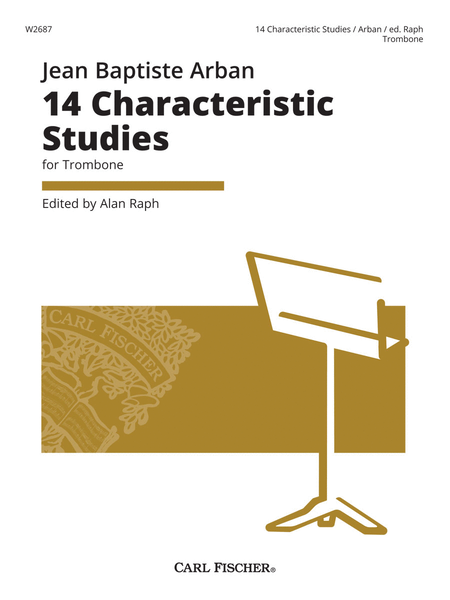14 Characteristic Studies
for Trombone
-
Ships in 1 to 2 weeks
Details
Description
SKU: CF.W2687
For Trombone. Composed by Jean-Baptiste Arban. Edited by Alan Raph. SWS. Collection - Performance. With Standard notation. 32 pages. Carl Fischer Music #W2687. Published by Carl Fischer Music (CF.W2687).ISBN 9781491150955. UPC: 680160908455. 9x12 inches.
This new edition of Jean Baptiste Arban's Fourteen Characteristic Studies for Trombone, edited by Alan Raph, was specifically written to "provide the student with suitable material with which to test his powers of endurance," according to Arban himself.
The following fourteen studies have been specifically written to provide the student withsuitable material with which to test his powers of endurance. In taking up these studies, he willdoubtless be fatigued, especially at the outset, by those numbers requiring an unusual length ofbreath. However, through careful study and experience he will learn to overcome the difficultiesand will acquire the resources which will enable him to master this particular phase of playingwith ease. As a means to this end, attention is drawn to cantabile passages in particular, whichshould be played with the utmost expression, yet at the same time with as much modified toneas possible. On the cornet, as with the voice, clear tones may be obtained by widening thelips and veiled tones by contracting them. This happy circumstance allows the performer anopportunity to rest while still continuing to play, and at the same time enables him to introduceeffective contrasts into the execution. It should be noted that by little artifices of this kind, andby skillfully conserving his resources, the player will reach the end of the longest and mostfatiguing pieces, not only without difficulty, but even with a reserve of strength and power,which, when brought to bear on the final measures of a performance, never fails to impress anaudience.At this point my task as professor (using the written instead of the spoken word) willend. There are things which appear clear enough when stated verbally but which when writtendown on paper cause confusion, seem obscure, and even sometimes appear trivial.There are other things of such an elevated and subtle nature that neither speech norword can clearly explain them. They are felt, they are conceived, but they are not to be explained;and yet these things constitute the elevated style, the grand ecole, which it is my ambition toestablish for the cornet, just as they already exist for singing and for the various kinds of otherinstruments.Those of my readers who are ambitious and who want to attain this high level ofperfection, should above all things, always try to hear good music well interpreted. Theymust seek out, among singers and instrumentalists, the most illustrious models, and by doingthis purify their taste, develop their sentiments, and bring themselves as near as possible tothat which is beautiful. Perhaps then the innate spark which may someday be destined todemonstrate their own talent, will reveal itself and render them worthy of being, in their turn,cited and imitated in the future.

 Share
Share